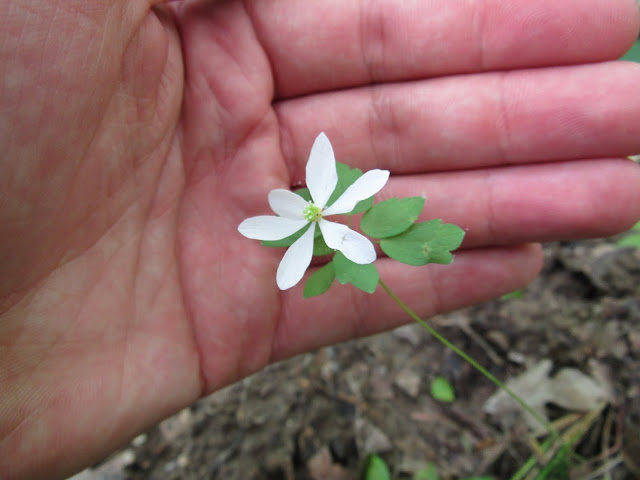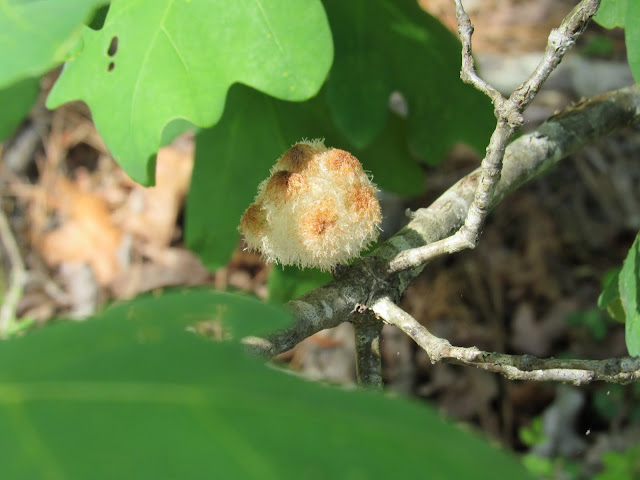Ozarks Spring 2017 Series
This is Part 2
... So, I left off here, with Nathan and Tayo stuck on a rock. They're currently still on that rock, a week after our trip. Hayley and I left them and wandered up to an open small set of glades/hill prairies, sunny grassy gaps in the woodland along the edge of the bluffs above.
Ok... Tayo and Nathan might have gotten off the rock and joined us, too. We found some wild Canada Onions (Allium canadense) in bloom on the glade, surprisingly all in flower without a single bulbil. This plant grows small bulbs often instead of flowers. However, on the glades here grows a flowers-only variety that seems to not cross the Mississippi River.
Nearby, I flipped over a rock and found the ever-present Fence Lizard (Sceloporus consobrinus), before it dashed away. It is a novelty of the Ozarks, the presence of lizards everywhere.
Another novelty was the abundance of fruticose (shrubby) lichen on the glades:
Several butterflies flitted about on this trail, and on the next trail, to Horseshoe Glade, including this favorite of mine, the Pearl Crescent (Phyciodes tharos):
Growing along the trail to Horseshoe Glade were some unusual-looking plants, that happened to be lifer Ozark Bunchflower (Veratrum woodii).
This can be found in Illinois very rarely, but it's far more common in the Ozarks of Missouri.
Blooming alongside was a fine Solomon's Seal (Polygonatum biflorum). This area got us dozens of ticks collectively, all over our pants and legs. We kept pulling them off as we went along, generally creeped out. I believe the group average for this hike was 20 a person, but some people had none and those who used our bugspray had significantly MORE ticks. I even tested this by not having bugspray on later and getting fewer ticks than those I was with who had it on. Evidently we need some new bugspray or anti-bug repellant of any kind.
We got to a side glade initially, and looked out over the St. Francois Mountains:
As we walked through the glade, after removing many of the ticks gained along the trail, I spotted a Lichen Grasshopper (Trimerotropis saxatilis), a species of well-camouflaged grasshopper found only in acidic igneous glades with lots of fruticose lichen (seen earlier). This glade fit the bill, but Horseshoe Glade did not. This ended up being one of the few Lichen Grasshoppers of the trip.
Also growing on this glade was a plant I've always wanted to see, a plant so famous it's literally called Fameflower. I have no idea why it's called Fameflower, but this particular example was the Small-flowered Fameflower (Phemeranthus parviflorus), which if you ask me is an excellent tongue-twister. At any rate, it's the majority of the plants growing in the photo below:
Next, we went back on the trail, which had improved into an open, tickless dry pine-oak forest. This came to a glade, the signature Horseshoe Glade of the trail.
Horseshoe Glade gets its name because it wraps around a creek and that creek's valley, so that the glade forms a "horseshoe" shape. At the tips of the "horseshoe", a mass of rock made for the perfect place to fully de-tick and eat our packed lunches.
Another Fence Lizard hid up here, and pretended not to be hiding in plain sight:
On the way back down, I spotted an unusually short, ground-flowering Spiderwort (Tradescantia sp.), something I presume to be a new species for me. We went back down, removed some more ticks, and then we decided to go to the Scour. It had been my idea to go to the glade, and it was Nathan's idea to visit the Scour. I'm not sure whose idea was better...
Speaking of which, let's discuss bears. Black Bears can be found in Missouri. However, the person at the visitor's center told us that they hadn't seen a bear in the area in a year. I would just like you to keep this fact in mind, as the events unfold.
The Scour trail began with a bargain- we traded ticks for mosquitoes. I'll take that deal- mosquitoes freak me out a lot less for some reason. The difference in soil moisture made for a new community of plants, including this strange-looking anemone-like plant I found.
Now, among our number was a woman named Hanna. Hanna liked to go ahead of us on the trail. She enjoys taking her time on trails, also, and she generally does not come straight back, at a brisk walk. Therefore, when she came immediately back at a brisk walk, we knew something was up. She informed us that after rounding a bend in the trail, she came upon a mother bear and two cubs. It is common sense to not mess with that combination, at risk of death. Mother bears are very defensive of their cubs. We decided to take the trail going the opposite direction and see what was down there several hundred feet away. I had my field hook, a titanium stick with a hook at the end for flipping logs, and I stayed to the back of our group, as I was probably the best-armed since I had that.
A very fat Fence Lizard met us at a far distance in the opposite direction. I presume this is a female with eggs, to be so obese.
We slowed down our pace, realized we had re-entered tick country and deticked, and took photos of the fungi. There were several unusual specimens about.
Perhaps the most strange was this fungus, growing off an oak tree. I don't know what it is, but it really fascinates me. I'm not even 100% sure that is a fungus, to be honest!
Something I am certain of is that this is White Wild Indigo (Baptisia alba), a favorite of mine.
We came to an opening in the trail, and we found this, an usual grove of Shortleaf Pines (Pinus echinata) growing in a tepee-like shape. This area had lots of Shortleaf Pines, the only real pine tree present in the Ozarks. Eastern Red-ceder also grows here, and the two are basically the only coniferous trees in the area. Yet they are also two of the most common trees here.
Here, Purple-stem Cliffbrake Fern (Pellaea atropurpurea) and Gray Beardtongue (Penstemon canescens) grow side-by-side. I've never seen the fern before, and this was also my first experience seeing Penstemons and Ferns growing side by side in nature. Generally ferns like lots of water, and penstemons disdain too much of it.
We walked through a stand of pines to reach the Scour, a modern development of Johnson's Shut-Ins. Back in 2005, this area was a typical wooded valley, like all the rest in the area. However, on December 14, 2005, something happened that changed Johnson's Shut-Ins State Park forever.
We looked at the Scour, but as it was hot and we lacked water, we didn't spend much time there. Plus there was still a wild bear or three about, so we went back and reported those to the visitor's center. I hope to come back and explore this area again- provided no floods occur when I visit!


























No comments:
Post a Comment